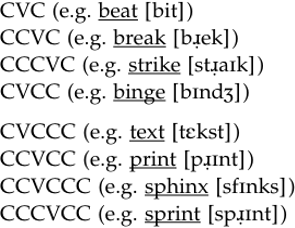


 Grammar
Grammar
 Tenses
Tenses
 Present
Present
 Past
Past
 Future
Future
 Parts Of Speech
Parts Of Speech
 Nouns
Nouns
 Verbs
Verbs
 Adverbs
Adverbs
 Adjectives
Adjectives
 Pronouns
Pronouns
 Pre Position
Pre Position
 Preposition by function
Preposition by function 
 Preposition by construction
Preposition by construction
 Conjunctions
Conjunctions
 Interjections
Interjections
 Grammar Rules
Grammar Rules
 Linguistics
Linguistics
 Semantics
Semantics
 Pragmatics
Pragmatics
 Reading Comprehension
Reading Comprehension|
Read More
Date: 2023-08-24
Date: 2024-03-07
Date: 2024-04-12
|
English Syllable Phonotactics
While we were talking about the syllabification of words that involve the use of two or more consonants in a row between vowels, the determination regarding which syllable they should belong to was made with reference to language-specific facts. For example, a word such as acne [ækni] will have the f irst consonant as the coda of the first syllable, and the second consonant as the onset of the second syllable. The obvious reason is that English does not allow /kn/ as an onset cluster. This will not be the case if we are talking about Norwegian (e.g. Knut), Hebrew (e.g. Knesset), Russian (e.g. kniga), or German (e.g. Knabe). It is time now to deal with the specifics of English syllable structure.
We start with the general formula, which can be stated as:

What this characterization says is that a V (vowel or diphthong), which is the nucleus, is the only obligatory element in an English syllable (e.g. a [e]). The surrounding consonants in parentheses are optional elements. Thus, we can have a V with one, two, or three consonants before it as single, double, or triple onsets:

Just as we can add consonants as onsets, we can add them as codas after the nucleus:

In the general formula given at the outset, there is also a fourth consonant in the coda, given in brackets. This is different than the others, because it is possible only if it belongs to a suffix, that is, if it comes from the following morpheme, as in bursts [bɝsts]. Single and multiple onsets can also be combined with single and multiple codas and create further possibilities:

Beyond these, the following are possible if we include suffixes:

CCCVCCCC is a logical possibility with no commonly found vocabulary.
The picture given above is still a very general one and does not include the numerous restrictions we have on onsets and codas.
|
|
|
|
التوتر والسرطان.. علماء يحذرون من "صلة خطيرة"
|
|
|
|
|
|
|
مرآة السيارة: مدى دقة عكسها للصورة الصحيحة
|
|
|
|
|
|
|
نحو شراكة وطنية متكاملة.. الأمين العام للعتبة الحسينية يبحث مع وكيل وزارة الخارجية آفاق التعاون المؤسسي
|
|
|